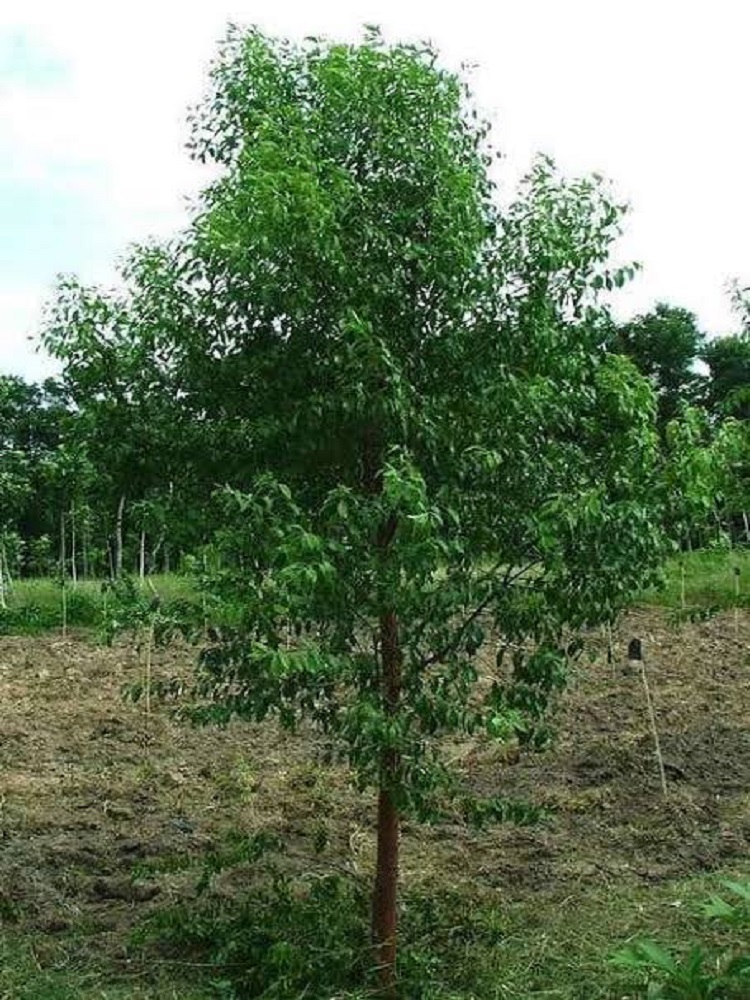Chandan - Sandal Tree

Santalum album
Summary
Scientific Classification
Kingdom: Plantae
Division: Magnoliophyta
Class: Magnolipsida
Order: Santalales
Family: Santalaceae
Genus: Santalum
Species: S.album
Scientific Name: Santalum albumL.
Common names
English : Sandalwood, Indian sandalwood, Fragrant sandalwood, White Sandalwood.
Hindi: Sandal, Chandan.
Marathi: Chandan, gandhachakod.
Kannada: Agarugandha, bavanna, bhadrasri, Gandhadha Mara, Chanadana.
Discription
- Habit and Habitat: A small evergreen glabrous tree with slender drooping branches with sap-wood white and odourless, the heart-wood yellowish brown, strongly scented.Sandalwood is an evergreen tree, growing up to 4-9 m tall. The trees have a long life, and may live up to one hundred years of age. The tree is variable in habit, usually upright to sprawling, and may intertwine with other species. The plant parasitises the roots of other tree species, but without major detriment to its hosts. The reddish or brown bark can be almost black and is smooth in young trees, becoming cracked with a red reveal. The heartwood is pale green to white as the common name indicates.
- Distribution: It is native to India, Indonesia, native to semi-arid areas of the Indian subcontinent. It is now planted in India, China, Sri Lanka, Indonesia, Malaysia, the Philippines and Northern Australia.
- Morphology:
Leaf: : The oval leaves are thin, oppositely arranged. Smooth surface is shiny and bright green, with a glaucous pale underside.Elliptic-lanceolate, subacute glabrous, entire thin, base acute, petiolate, petioles slender.Leaves thin, usually opposite, ovate or ovate elliptical, 3-8 x 3-5 cm, glabrous and shining green above, glaucous and slightly paler beneath; tip rounded or pointed; stalk grooved, 5-15 cm long; venation noticeably reticulate.
Inflorescence: Terminal and axillary paniculate cymes.
Flowers: Flowers bisexual.Brownish-purple, inodorous, perianth campanulate, limb of 4 valvet triangular segments Flowers purplish-brown, small, straw coloured, reddish, green or violet, about 4-6 mm long, up to 6 in small terminal or axillary clusters, unscented in axillary or terminal, paniculate cymes.tepals 5, basally connate into a campanulate tube of 2 mm long, shortly connate to the basal part of the ovary; lobes 2.5 x 1.5 mm, ovate, thin, fleshy, glaucescent without, minutely ciliate.
Androecium: stamens 4, exserted, alternating with 4 rounded obtuse scales, filaments 1 mm; anthers 0.7 mm, ovoid, 2-celled; Gynoecium: ovary superior later half inferior at the time of flowering, globose, 1 mm, 1-celled, ovules 2-3, pendulous from below the long, acuminate, central.
Fruit: Fruit a globose, fleshy drupe; red, purple to black when ripe, about 1 cm in diameter, with hard ribbed endocarp and crowned with a scar, almost stalkless, smooth, single seeded.
Seeds: albuminous, seed one.
Flowering and Fruiting time: February or March – August Flower panicles appear from March to April in India, and fruits ripen in the cold season; in Australia flowers appear in December to January and also June to August, and mature fruit is available from June to September. - Propagation: Through seeds.
-
Importance:
a.Wood ground up with water into a paste, is applied to local inflammations, to temples in fever, in skin diseases, to allay heat and pruritus.
b.It acts as diaphoretic.
In cases of morbid thirst wood-powder is taken in coconut water.
c.A bolus of ground sandal cheeks-hoemoptysis in mild form.
d.Essential oil from wood is used in perfumery and is a remedy as demulnent, diuretic and mild stimulant in gonorrhea and chronic cystitis.
e.Oil from the seeds is used in skin diseases.
f.Sandalwood oil was used traditionally to treat skin diseases, acne, dysentery, gonorrhea, and a number of other conditions.
g.In traditional Chinese medicine, sandalwood oil is considered an excellent sedating agent. - Location:
 Trees of Empress Botanical Garden - Project supported by
Trees of Empress Botanical Garden - Project supported by